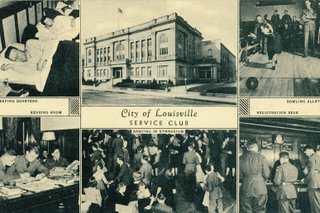I recently purchased a used book on EBay, Good Girls, Good Food, Good Fun: the Story of USO Hostesses During World War II by Meghan K. Winchell. I was both excited and sadden when I opened it and read the inscription dated Dec. 2017. “Dear Denice, I hope this book will act as a reminder to you of our time together at the USO. What a true blessing it is to have you as a “partner” at the USO but more importantly as a friend! I hope that our time at the USO continues for a long while. When those days do come to a close, I know we will continue our friendship. Thank you! Merry Christmas! Ellen.” I wondered about who Denice and Ellen were. Had Denice passed and family donated this book that I purchased from a used book store, and what were the experiences that kept them bonded for so many years. This month’s article is dedicated to Denice, Ellen and all the women that volunteered for the USO during WWII.
Founded in New York on February 4, 1941 the mission of the United Service Organization (USO) provided recreation and aid to military personnel and workers in wartime industry. USO clubs were a “Home Away from Home.” The government agreed to supply building materials, locations, and labor to build structures while six civilian organizations (Salvation Army, Jewish Welfare Board, National Catholic Community, Young Men’s Christian Association, Young Women’s Christian Association, and the Traveler’s Aid Society) would organize and run the operations. These operations would eventually include 3,000 community USO clubs, travel services, mobile units, and the famous camp shows.
The USO Clubs were either built for this specific purpose; the first in Fayetteville, NC which still serves as a USO club for nearby Fort Bragg, or took over other buildings. Each club hired a Director and Assistance Director but depended on the dedicated team of Senior and Junior Hostess volunteers to fulfill their mission. Each club provided the basic services but was flexible and could specialize as each community’s needs varied. So one club might have more live entertainment like dances, outings, and sporting activities, while others might provide daycare and activities for wives and families of servicemen stationed nearby. Some clubs operated 24 hours, seven days a week to accommodate war industry workers who needed the clubs services.
Although the club dances and celebrity shows are well known it is the less documented services that illustrate the service of the USO. Legend has it that the volunteers in Sayre, PA once fed 30,000 servicemen in one evening when the troops were stuck in transit in the town’s railroad depot. Another admirable contribution is noted in Emily Yellin’s book, Our Mothers’ War. A young married woman who volunteered at a USO club operated an audio recorder for servicemen who wanted to send messages onto special record-like disks that would be sent to their families. She recalled when a hospital ship came in. Men on crutches or bandaged who came in to record a message to tell their wives or mothers that they had lost a limb. She vividly recalled how the men would break down as they tried to explain what happened, so that when they got home it wouldn’t be such a shock. The comfort these volunteers provided for servicemen and their families is immeasurable. As Yellin wrote, “I think the word “service” in the United Service Organization is the key word in all of this. When we value service in the same way we value warfare, that’s when people who provide these services will get the credit they deserve.”
For more about the USO during WWII read the two books mentioned above or visit www.ww2uso.org/history.



